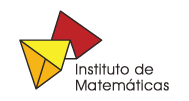Coloquio del IMUNAM - C. U. febrero 2024
Auditorio Alfonso Nápoles Gándara
https://www.matem.unam.mx/actividades/coloquio/cu/actividades
Programa febrero 2024
--------------------------------------------------
12:00 horas
Auditorio “Alfonso Nápoles Gándara”
---------------------------------------------------
Martes 6
“New uniformizations of some moduli spaces of curves with marked points”
Bertrand Deroin, Universidad de Cergy/CNRS, Francia
Resumen: will report on some work in collaboration with Julien Marché, in which we constructed some compactification of the moduli spaces of curves of genus g with n marked points carrying a complex hyperbolic structure, in the cases (g,n)= (0,4),(0,5),(1,2),(1,3) and (2,1). This extends classical works of Hirzebruch (cas e (g,n)=(0,5)), Livne (case (g,n)=(1,2)), and this gives a negative answer to a
question asked by Siu in the eighties: there exists a holomorphic submersion X-->Y between compact complex hyperbolic manifolds X,Y of
dimensions dim X>dim Y >1. These constructions are based on the analysis of some topological properties of quantum projective
representations of the mapping class group.
https://www.matem.unam.mx/actividades/coloquio/cu/actividades/new-uniformizations-of-some-moduli-spaces-of-curves-with-marked-points
Martes 13
"Algunos ejemplos de algoritmos certificadores
en gráficas"
César Hernández Cruz, Facultad de Ciencias, UNAM
Resumen:
Martes 20
“Parallel and Dynamic Algorithms for PageRank - Are Random Walks Necessary?”
Piotr Sankowski, Universidad de Varsovia
Resumen: In my talk I will discuss techniques that allow for efficiently generating many independent random walks from starting from all nodes in a graph. This computational routine is often used for computing the PageRank vector which is a fundamental data science notion. I introduce how to implement such random walk generation in the context of the Massive Parallel Computation (MPC) model as well as dynamic computations. More specifically, I will discuss:
- how to maintain such a set of random walks in undirected graphs in polylogarithimic update time,
- how to compute such a set of random walks in MPC model in polyloglog time.
These results immediately lead to efficient approximation algorithms for the PageRank problem in respective scenarios.
On the negative side we provide an Ω(n^{1−δ}) lower bound for the amortized update time of any algorithm that explicitly maintains a constant multiplicative approximation of PageRank in the insertion- or deletion-only model in directed graphs, what resolves a 13-year old open question of Bahmani et al. (VLDB 2010). In order to obtain efficient algorithms, we look beyond the relative error goal, and demonstrate that a simple batch recomputation algorithm can maintain good approximations to PageRank under L_1 error. We evaluate this similar algorithm empirically and demonstrate that it delivers similar preformacje while being much simpler .
Based on joint work with Rajesh Jayaram, Kuba Łącki, Slobodan Mitrović, Krzysztof Onak.
https://www.matem.unam.mx/actividades/coloquio/cu/actividades/parallel-and-dynamic-algorithms-for-pagerank-are-random-walks-necessary
Martes 27
“Funciones semicontinuas en variedades demódulos”
Daniel Labardini. IMUNAM
Resumen: XX
https://www.matem.unam.mx/actividades/coloquio/cu/actividades/funciones-semicontinuas-en-variedades-de-modulos

